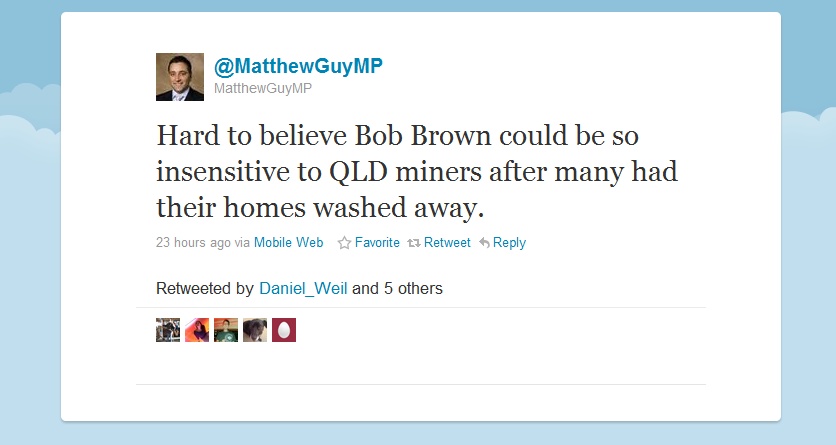 Back when I was writing for Planning News, I wrote an editorial about Justin Madden’s handling of the Windsor Hotel debacle. My point then was that politicians are not well served by the over-manipulation of their communication, which ends up alienating the public and cutting politicians off from legitimate sources of feedback. It has therefore been great to see that the new Victorian Planning Minister Matthew Guy has kept up with his twitter account and is obviously writing the posts himself rather than letting a media person do it. So rather than the usual drip feed of press releases, Guy’s account is full of obviously self-generated content that a media adviser would have probably tried to talk him out of, such as salutes to Joh Bjelke-Petersen and amusingly childish baiting of Labor politicians. To his credit, too, he has been responding directly to various tweets sent to or about him. (Update – 19/1/2011: He has now protected his tweets. I can’t see them now so I have no idea whether he’s deleted them or not).
Back when I was writing for Planning News, I wrote an editorial about Justin Madden’s handling of the Windsor Hotel debacle. My point then was that politicians are not well served by the over-manipulation of their communication, which ends up alienating the public and cutting politicians off from legitimate sources of feedback. It has therefore been great to see that the new Victorian Planning Minister Matthew Guy has kept up with his twitter account and is obviously writing the posts himself rather than letting a media person do it. So rather than the usual drip feed of press releases, Guy’s account is full of obviously self-generated content that a media adviser would have probably tried to talk him out of, such as salutes to Joh Bjelke-Petersen and amusingly childish baiting of Labor politicians. To his credit, too, he has been responding directly to various tweets sent to or about him. (Update – 19/1/2011: He has now protected his tweets. I can’t see them now so I have no idea whether he’s deleted them or not).
All this is good, and an advance on Labor’s media management, which makes me somewhat reluctant to pick on things he has said. But this morning he re-tweeted this comment from the 3AW feed:
Neil Mitchell: I would take Bob Brown and put him in cage with the looters and scam artists and put him in a river .. he’s a dill
While a re-tweet isn’t necessarily an endorsement, there is no suggestion by Guy that he is posting it as, for example, an example of an unhelpful contribution to the debate. Where do we start with this?
